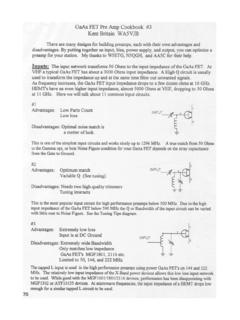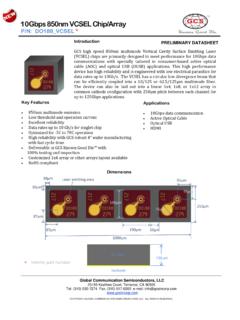Transcription of Charge Redistribution at GaAs/P3HT …
1 Charge Redistribution at GaAs/P3HT Heterointerfaces with DifferentSurface PolarityJun Yin, Dmitri B. Migas, Majid Panahandeh-Fard, Shi Chen, Zilong Wang, Paola Lova, and Cesare Soci*, , Division of Physics and Applied Physics, School of Physical and Mathematical Sciences and Centre for Disruptive PhotonicTechnologies, Nanyang Technological University, 21 Nanyang Link, Singapore 637371 Belarusian State University of Informatics and Radioelectronics, 6 P. Browka Str., Minsk 220013, Belarus*SSupporting InformationABSTRACT:The nature of charged photoexcitations at the interface of highlydelocalized inorganic crystals and more localized conjugated polymer systems is of greatfundamental interest for a number of hybrid photovoltaic applications. Here we study theinteraction between mainstream compound semiconductor gaas and conjugated polymerP3HT by means of density functional theory simulations. When considering both nonpolarGaAs(110) and polar gaas (111)B surfaces, wefind that polarity of the gaas surfacestrongly affects the electronic orbitals and Charge Redistribution : electrons are efficientlytransferred to gaas substrates, implying the formation of hybrid delocalized states at theinterface.
2 Furthermore, p3ht can act as an acceptor for gaas (111)B via hole transferfrom gaas valence band states. Overall the intrinsic surface dipole moment of GaAssurfaces is enhanced by the Charge displacement induced by adsorbed p3ht . Thesetheoretical predictions correlate well with energy alignments derived by ultravioletphotoelectron spectroscopy and provide a robust methodology for the design of polymer/III V heterointerfaces that optimize photovoltaic :Physical Processes in Nanomaterials and NanostructuresOrganic inorganic hybrid photovoltaic (PV) systems, forinstance, conjugated polymers blended with function-alized inorganic nanoparticles or nanorods,1,2offer greatflexibility for the design of solar cells with large powerconversion efficiency (PCE).3 5 The overall photocurrent ofhybrid PVs is primarily affected by the competition betweeninterfacial Charge separation and Charge , the energy alignment between the conjugatedpolymer and the inorganic semiconductor is chosen so thatthe inorganic semiconductor acts as electron acceptor,facilitating dissociation of the photogenerated excitons andpreventing Charge processes dependstrongly on the atomic configurations and electronic structuresat the interface as well as on the electronic coupling betweenthe polymer and the semiconductor nature ofcharged photoexcitations at the interface of highly delocalizedinorganic crystals and more localized, disordered conjugatedsystems is indeed of great fundamental interest but not yetcompletely 13 gaas , a mainstream III V compound semiconductor withhigh carrier mobility and direct bandgap absorption well-overlapped with the solar irradiance.
3 Is rapidly emerging asexceptional PV material for thinfilm technologies,14includingdye or polymer sensitized hybrid solar 18 Earlydemonstration of a hybrid PV cell based on a quaterthio-phene/ gaas bilayer yielded PCE;15more recently, use ofGaAs nanowires blended either in p3ht bulk heterojunc-tions16or in a bilayer thin-film configuration17,19allowedachieving PCEs of > and , very promising device performances, current under-standing of the electronic properties leading to Charge transferat organic inorganic interfaces like GaAs/P3HT is instance, the effects of surface polarity on chargeredistribution and the nature of hybrid excitations formed uponcharge transfer between highly delocalized electronic states ofthe crystal, and less extended states of the polymer areunknown. In this work, we investigate the structural andelectronic properties of thin P3 HTfilms deposited on polarGaAs(111)B and nonpolar gaas (110) substrates.
4 First-principle, total-energy calculations are used to study theorientation and position of p3ht molecules at the differentinterfaces and to determine stable atomic of states and Charge density rearrangement due tothe formation of the interface suggests the formation of hybridstates upon photoexcitation. Calculated electronic energystructure at the GaAs/P3HT interfaces and electronic couplingbetween gaas surfaces and the p3ht molecules display a goodagreement with X-ray photoelectron spectroscopy (XPS) andultraviolet photoelectron spectroscopy (UPS) experimentalReceived:July 15, 2013 Accepted:September 17, 2013 Published:September 17, 2013 American Chemical | , 4, 3303 3309results. Finally, contributions of ground-state Charge -transferprocesses for different surface polarities are identified,indicating that electron and hole accumulation layers may beengineered, controlling the gaas crystal orientation to optimizePV simulations proceeded through the optimization of thestructural conformations of p3ht crystal in contact with GaAssurfaces, followed by full atomistic relaxation to determineelectronic couplings andfinally the Charge density redistrib-ution after electron and hole transfer.
5 After structuraloptimization, the polar gaas (111)B surface shows stablealignment of the outmost layer, while the nonpolarGaAs(110) surface experiences a strong reorganization of theoutmost layer, where As and Ga atoms display outward andinward relaxation, respectively. This is in good agreement withprevious ,22 Surface relaxation causes the enlarge-ment of Ga As bonds in the gaas (111)B surface bilayer ( to ) and the reduction of Ga As bonds in theGaAs(110) surface bilayer (from to ). Similar tothe known case of ZnO/ p3ht interface, we assume that vander Waals interactions of thiophene band and side-chain forcephysisorbed p3ht molecules to layflat on the gaas et shown that the LDA method accuratelydescribes ZnO and p3ht interactions, although it somehowfails accounting for long-range van der Waals attractivecomponents. Here we also adopt the LDA method to modelthe interactions between the gaas surface and p3ht , butinstead of calculating a large and thick gaas supercell withP3HT polymer interfacial system, we use the outmost bilayer ofthe gaas surface to represent the original gaas surface and tworepeated p3ht molecules to represent the polymer, a commonapproach to study the bonding energy of ,24 The most stable adsorption sites of the P3 HTmolecule on gaas (110) and gaas (111)B bilayer surfaces areshown in Figure 1a,a.
6 Structural optimization was carried outthrough various energy minimization steps: atfirst, the stableinterfacial distances between the p3ht molecular plane andthe gaas (110) and gaas (111)B bilayer surface weredetermined to be and , respectively. (Thesedistances correspond to the minima of the binding energycurves provided as Supporting Information, Figure S1.) Then,the most stable configurations along thexandyaxes werefound to be atx= andy= 2 for gaas (110) (Figures1b,c) andx= andy= 0 for gaas (111B) (Figures1b ,c ) while the optimal rotational angle in thex yplane was0 (Figure S2 in the Supporting Information). Therefore, forFigure optimization of p3ht adsorbed on gaas surfaces: top views of the optimized geometry of p3ht on gaas (110) (a) and onGaAs(111)B (a ); binding energy of a p3ht molecule on gaas (110) (b,c) and on gaas (111)B (b ,c ) surfaces as a function of its relative positionalong Journal of Physical Chemistry | , 4, 3303 33093304both gaas surfaces the minimum energy configuration of theP3HT molecule occurs when the sulfur atom overlaps with theunderneath arsenic atom on the gaas surface and the hexylchain is aligned along thexaxis.
7 This analysis of interfacialconfiguration of p3ht / gaas bilayers provides the startingpoint for further atomic relaxation and calculation of GaAs/P3HT electronic transfer across GaAs/P3HT interfaces willultimately determine Charge generation efficiency for PVapplications. The efficiency of electron transfer mainly dependson the interfacial energy alignment between the conjugatedpolymer and the inorganic substrate, the electronic couplingsbetween them, and the change of the polymer geometric andelectronic structure due to the , ultrafast pump probe experiments in gaas /oligothiophene systems have shown that electron transfer tothe conduction band of gaas occurs upon exciton diffusiontoward the theory, Prezhdo et al. gavedetailed time-domain atomistic descriptions of the interfacialcharge separation and relaxation processes in hybrid the case of alizarin/TiO2interface, the adiabatic mechanismdominates over nonadiabatic ones due to the strong couplingacross the the case of graphene/TiO2interface,electron injection is found to be ultrafast due to the strongelectronic coupling between graphene and TiO2, and bothelectron injection and energy transfer accelerate for photo-excited states that are delocalized between the idealized gaas (10 10)/ p3ht interface wasinvestigated theoretically by DFT modeling, showing that theresulting interfacial dipole can lower the highest occupiedmolecular orbital (HOMO)
8 Of the conjugated polymer until thewhole system attains alignment of the energy levels and the coupling of theelectronic wave functions between a polymer and a semi-conductor substrate can be obtained from the analysis of thetotal density of states (DOS) and of the projected density ofstates (PDOS) after Charge are shownfor gaas (110) and (111)B/ p3ht interfaces in Figure 2. Figure2a,a shows that the overall DOS of the gaas and P3 HTcombined system (black lines) is largely dominated by theprojected DOS of gaas (shaded area), while the projectedDOS of p3ht (purple line) only slightly perturbs the top ofthe valence band of gaas . States of the p3ht molecule extendover a broad energy range, and there is large overlap betweenthe lowest unoccupied molecular orbital (LUMO) level ofP3HT (LP3HT) and the conduction band of gaas comparedwith the relatively small overlap of the HOMO of p3ht (HP3HT) and the gaas valence band. This results in strongelectronic coupling between the p3ht molecule and the of the frontier orbitals of the p3ht moleculeinteracting with the gaas substrate is carried out tocharacterize orbital overlapacross the interface.
9 Figure2b,b ,c,c shows the spatial distribution of the electron densitydistribution calculated at the HOMO and LUMO energies ofP3HT. Compared with reference bulk gaas , the bandgap ofGaAs(110) slab is lowered as much as eV. (See Figure S3 inthe Supporting Information.) In the case of gaas (110)/ p3ht ,electrons may be efficiently transferred to the bulk of the GaAscrystal thanks to the highly overlapped electron clouds seen atthe interface, suggesting the possibility to form hybriddelocalized states. Hole transfer is unfavorable and in anycase would be confined to surface states of gaas (110) due tothe poor overlap between the corresponding conduction bandand HOMO the case of the polar gaas (111)B surface, the DOS isseverely affected by the presence of surface dangling bonds(Figure 2b ): As-4p states of the top surface layer and Ga-4pstates of the bottom surface layer (not included in thecalculations) lie right at the Fermi level inside the bandgap,which results in the appearance of a large number of intragapstates and in significant narrowing of the energy bandgap uponlowering of the conduction band lowering ofGaAs(111)B conduction band has a dramatic effect on therelative overlap between gaas and p3ht states and changesthe resulting electron density distribution.
10 In the specific, theconduction band of gaas (111)B gains overlap with theFigure of states and electronic orbital distribution in gaas (110)/ p3ht (left) and gaas (111)B/ p3ht (right) hybrid systems: (a,a )density of states (the dashed line indicates the position of the Fermi energy); Charge distribution of the electron (b,b ); and hole (c,c ) Journal of Physical Chemistry | , 4, 3303 33093305 HOMO of p3ht , facilitating hole transfer from gaas (111)Bto p3ht . Whereas electron transfer from p3ht toGaAs(111)B may be significantly reduced compared with theprevious case and somehow confined to the gaas (111)Bsurface, holes are allowed to delocalize from the thiophene ringover to the gaas (111)B surface states and deeply into the bulkthanks to the larger quantify the actual Charge transfer and separationprocesses between polymer and semiconductor substrates, weevaluated the Redistribution of Charge density upon P3 HTadsorption and estimated the changes of interfacial dipolemoment and work function that it organic/inorganic heterojunctions, adsorption of organic molecules onthe inorganic substrate is always accompanied by a certaindegree of rearrangement of the electronic Charge density acrossthe interface.









